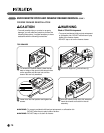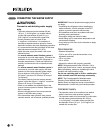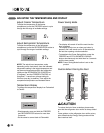
19
CONNECTING THE WATER LINES
IMPORTANT: Before connecting the tubing to the water
line, unplug the refrigerator or disconnect the power.
• Turn off the main water supply and open the nearest
faucet to relieve pressure in the line. Opening an outside
faucet may help drain water from the line in the house.
• Find a 1/2-in. vertical COLD water pipe near the
refrigerator.
NOTE: A horizontal pipe will work, but the following
precaution must be taken: drill on the top of the pipe, not the
bottom. This will help keep water away from the drill and
also keep normal sediment from collecting in the valve.
• To determine the length of copper tubing you will need,
measure from the connection on the lower left rear of the
refrigerator to the water pipe. Add 7 ft. (2.1 m) to allow for
moving the refrigerator for cleaning. Use 1/4-in. O.D.
(outside diameter) copper tubing. Be sure both ends of the
copper tubing are cut square.
• Using a drill, drill a 1/4-in. hole in the cold water pipe you
have selected.
• Fasten the shutoff valve to the cold water pipe with the
pipe clamp. Be sure the outlet end is solidly in the 1/4-in.
drilled hole in the water pipe and the washer is under the
pipe clamp. Tighten the packing nut. Tighten the pipe
clamp screws carefully and evenly so the washer makes a
watertight seal.
Do not overtighten or you may crush the copper tubing,
especially if soft (coiled) copper tubing is used. Now you
are ready to connect the copper tubing.
• Slip the compression sleeve and the compression nut onto
the copper tubing as shown. Insert the end of the tubing
into the outlet end squarely as far as it will go. Screw the
compression nut onto the outlet end with a wrench. A flare
nut wrench works best, but an open-end wrench will
suffice. Do not overtighten.
• Place the free end of the tubing into a container or sink,
and turn on the main water supply. Flush out the tubing
until the water is clear. Turn off the shutoff valve on the
water pipe. Coil the copper tubing as shown below.
ENGLISH
IMPORTANT: Before connecting the tubing to the
refrigerator, be sure the refrigerator power cord is not
plugged into the wall outlet.
NOTE: If your refrigerator is equipped with an internal water
filter, an external in-line water filter should not be used.
• Remove the plastic flexible cap from the water valve.
• Place the compression nut and ferrule (sleeve) onto the
end of the tubing as shown.
• Insert the end of the copper tubing into the connection as
far as possible. While holding the tubing, tighten the fitting.
IMPORTANT: Tighten any connections that leak.
Open the water at the shutoff valve.
• Plug in the refrigerator.
• Arrange the coil of copper tubing behind the refrigerator so
it does not vibrate against the back of the refrigerator or
against the wall.
• Check for leaks.
• Before connecting the water line to house, purge the
house line for 2 minute.
NOTE: It may take a few seconds for water to begin to flow
as the internal tank fills and air clears from the lines.
• Push the refrigerator back to the wall.
• Set the icemaker switch to the ON position.
NOTE: The icemaker will not begin to operate until it
reaches its operating temperature of 15°F (-9°C).
It will then begin operation automatically.
NOTE: Throw away the first few batches of ice (about
20 pieces).
Packing
Nut
Shutoff
Valve
Compression
Sleeve
Compression
Nut
Cold Water Pipe
Pipe Clamp
Coil of Polyethelyne
or Copper Tubing
Ferrule
(Sleeve)
Refrigerator
Connection
Water
valve
Tubing
Clamp
1
/
4"
Tubing
1
/
4"
Compression
Nut


















